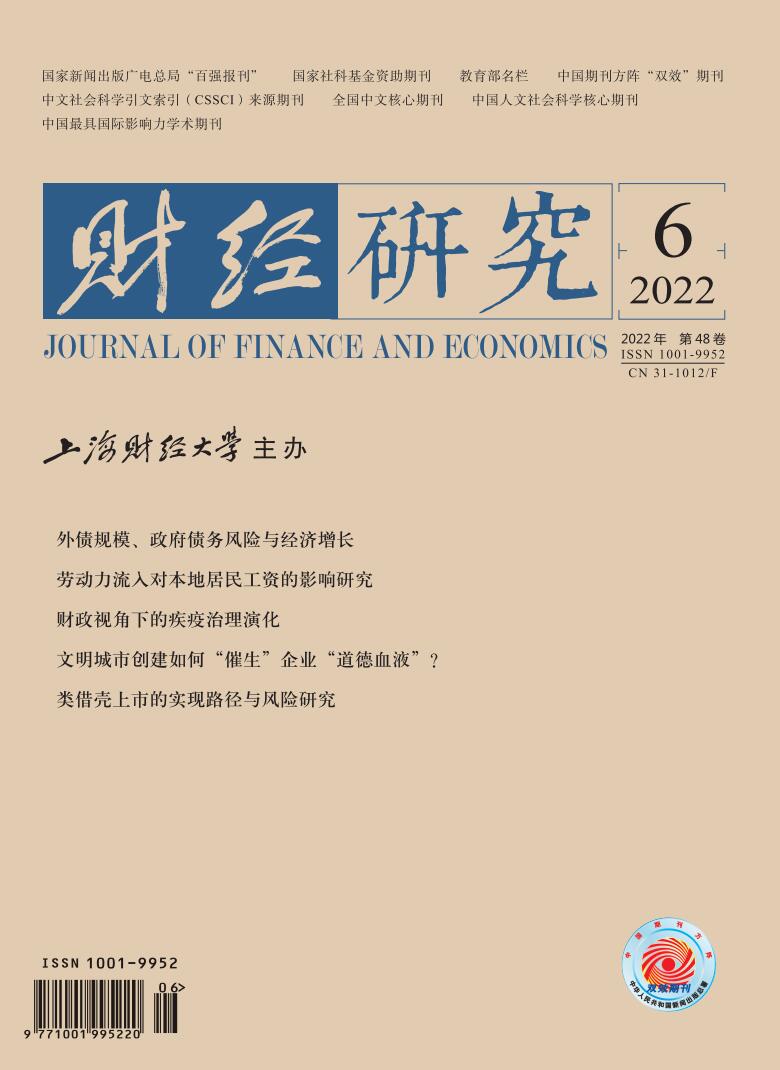近年来,我国面临经济下行压力持续增加而政府债务负担不断攀升的局面,那么政府部门能否进一步加杠杆从而确保积极财政政策的可持续性成为各界高度关注的重要问题。文章基于我国政府债务中的外债占比偏低的典型特征,收集了全球35个主要经济体2001—2018年的季度数据,从外债占比视角对这一问题进行了系统分析。研究表明,一方面,政府债务中的外债占比偏低有助于降低系统性金融风险爆发的概率,因此可以视为政府债务问题的“安全垫”,这有助于拓宽政府部门的加杠杆空间;另一方面,政府债务中的外债占比偏低会通过“外债占比偏低—对投资的拉动作用减弱—政府债务对经济的推动作用减弱”和“外债占比偏低—对全要素生产率的拉动作用减弱—政府债务对经济的推动作用减弱”这两条机制,弱化政府债务对经济增长的推动作用。因此,外债占比偏低是我国在“防风险”方面的一大优势,使得中央政府具有进一步加杠杆的空间,从而确保积极财政政策的可持续性;但是,政府债务过于依赖内债也在一定程度上制约了其在“稳增长”方面的作用。未来我国可以适度优化外债规模,更好地在“防风险”与“稳增长”中寻求动态平衡。
外债规模、政府债务风险与经济增长
摘要
参考文献
2 陈小亮, 刘哲希, 郭豫媚, 等. 宏观经济政策研究报告2020[M]. 北京: 科学出版社, 2020.
6 贾俊雪, 郭庆旺. 财政规则、经济增长与政府债务规模[J]. 世界经济,2011,(1):73−92. DOI:10.3969/j.issn.0488-6364.2011.01.005
7 李超, 马昀. 中国的外债管理问题[J]. 金融研究,2012,(4):84−97. DOI:10.3969/j.issn.1674-2265.2012.04.019
8 刘洪钟, 杨攻研, 尹雷. 政府债务、经济增长与非线性效应[J]. 统计研究,2014,(4):29−38. DOI:10.3969/j.issn.1002-4565.2014.04.004
22 Baldacci E, Kumar M S. Fiscal deficits, public debt, and sovereign bond yields[R]. IMF Working Paper No. WP/10/184, 2010.
23 Brunnermeier M K, Oehmke M. The maturity rat race[J]. The Journal of Finance,2013,68(2): 483−521. DOI:10.1111/jofi.12005
24 Cecchetti S G, Mohanty M S, Zampolli F. The real effects of debt[R]. BIS Working Paper No. 352, 2011.
26 Dalio R. A template for understanding big debt crises: How to get the grades, get the job, and get the checks![M]. Chicago: November Media Publishing & Consulting Firm, 2018.
27 Drehmann M, Juselius M. Evaluating early warning indicators of banking crises: Satisfying policy requirements[J]. International Journal of Forecasting,2014,30(3): 759−780. DOI:10.1016/j.ijforecast.2013.10.002
28 Eichengreen B, Hausmann R. Exchange rates and financial fragility[R]. NBER Working Paper No. 7418, 1999.
29 Fisher I. Booms and depressions[M]. New York: Adelphi Company, 1932.
30 Gennaioli N, Martin A, Rossi S. Sovereign default, domestic banks, and financial institutions[J]. The Journal of Finance,2014,69(2): 819−866. DOI:10.1111/jofi.12124
31 Levine R, Loayza N, Beck T. Financial intermediation and growth: Causality and causes[J]. Journal of Monetary Economics,2000,46(1): 31−77. DOI:10.1016/S0304-3932(00)00017-9
32 Maestas N, Mullen K J, Powell D. The effect of population aging on economic growth, the labor force and productivity[R]. NBER Working Paper No. 22452, 2016.
33 Minsky H P. Stabilizing an unstable economy[M]. New Haven: Yale University Press, 1986.
34 Pattillo C, Poison H, Ricci L A. External debt and growth[J]. Review of Economics and Institutions, 2011, 2(3): Article 2.
35 Reinhart C M. This time is different chartbook: Country histories on debt, default, and financial crises[R]. NBER Working Paper No. 15815, 2010.
36 Reinhart C M, Rogoff K S. Growth in a time of debt[J]. American Economic Review,2010,100(2): 573−578. DOI:10.1257/aer.100.2.573
37 Reinhart C M, Rogoff K S. From financial crash to debt crisis[J]. American Economic Review,2011,101(5): 1676−1706. DOI:10.1257/aer.101.5.1676
38 Romer C D, Romer D H. Fiscal space and the aftermath of financial crises: How it matters and why[R]. NBER Working Paper No. 25768, 2019.
39 Tepper A, Borowiecki K J. A leverage-based measure of financial instability[R]. Federal Reserve Bank of New York Staff Reports No. 688, 2014.
40 Turner A. Between debt and the devil: Money, credit, and fixing global finance[M]. New Jersey: Princeton University Press, 2015.
引用本文
刘哲希, 王兆瑞, 陈小亮, 等. 外债规模、政府债务风险与经济增长[J]. 财经研究, 2022, 48(6): 4-18.
导出参考文献,格式为:





 4737
4737  9386
9386

